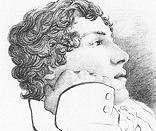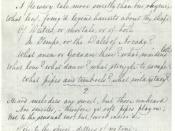"The excellence of every art is its intensity, capable of making all disagreables evaporate from their being in close relationship with Beauty and Truth."
John Keats
John Keats was born October 31, 1795. Keats published three books of poetry during his lifetime, but was dismissed as a middle-class interloper by most critics. He had no advantages of birth, wealth, or education; he lost his parents during his childhood, watched one brother die of tuberculosis and the other emigrate to America. Poverty kept him from marrying the woman he loved. And he achieved lasting fame only after his early death in 1821. Yet grief and hardship never destroyed his passionate commitment to poetry.
John Keats wrote "Ode on a Grecian Urn" in 1819. This ode is based on a series of paradoxs and opposites on the discrepancy between the urn with its frozen images and the dynamic life portrayed on the urn, the human and changeable versus the immortal and permanent, participation versus observation, and life versus art.
A "Grecian Urn" is an ancient vase with a work of art printed on it. Keats would often times use his poetry to create a world of pure joy, but in this poem the world of fantasy is the life of the people on the urn. Keats sees them, simultaneously, as carved figures on the marble vase and live people in ancient Greece. Existing in a frozen or suspended time, they cannot move or change, nor can their feelings change, yet the unknown sculptor has succeeded in creating a sense of living passion and turbulent action. The real world of pain contrasts with the fantasy world of joy. Initially, this poem does not connect joy and pain. "More happy love! more happy, happy love!" (Keats, line 25). When one reads lines...



Ode on a grecian urn
You have shown insight into this poem, however the change in language style within the body of your text hints that you are quoting from others. Please provide them with the courtesy of a reference
1 out of 1 people found this comment useful.